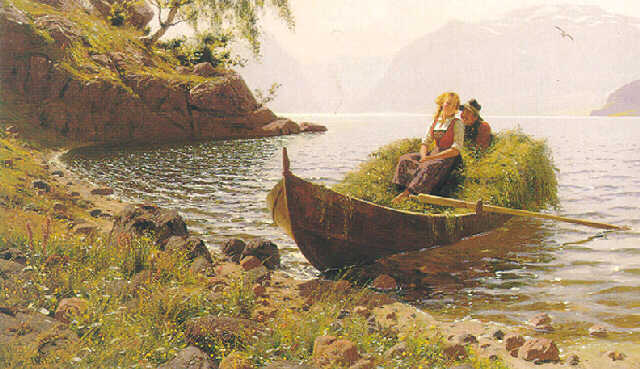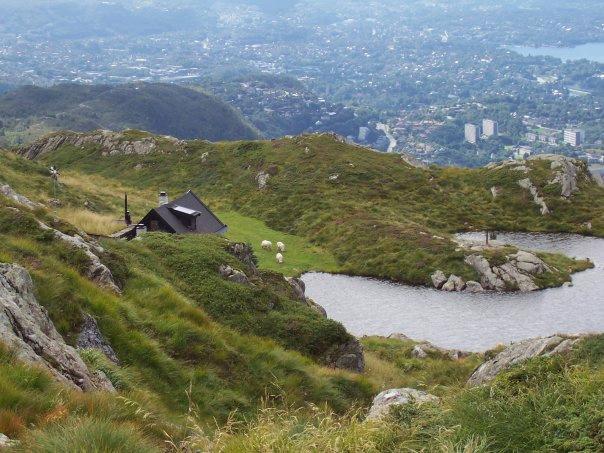0















| Thumbs Up |
| Received: 433 Given: 0 |

Rural Norway Over One Hundred Years Ago - by Olaf A. Hougen (1893–1986)
Over the span of more than one hundred years, the changes in methods of agriculture, and in the peasant life of Norway have been equally as great as those on the farms in America. One hundred years ago each farm was an independent, self-sufficient community. Each farm consisted of a number of buildings, sometimes as many as twenty, gradually accumulated through the centuries. A few of these buildings are still in remarkable preservation and livable, even after six hundred years. These buildings were arranged in two courts. The inner court comprised a house for the farmer’s family, a house for the parents, the stabbur, the shops for woodwork, tool sharpening, blacksmithing, and a barn for the horses. The stabbur is a characteristic two-story Norwegian building, built of logs, with the second floor projecting as a balcony over all four sides and supported at its corners high off the ground by piles of stones or posts, hence the name stabbur. The elevation was a protection against the invasion of animals and insects. The stabbur serves as a storage house for flour, meat and grain. Because of the gradual change of temperature in the course of the year, without sudden fluctuation and with temperatures scarcely ever exceeding 80 degrees in summer, meat may be kept in these stabburs for eight or more years without spoiling despite lack of refrigeration. It was formerly the custom for the marriageable daughters of the household to sleep on the upper floor of the stabbur. The portals of the stabbur and front balcony were usually highly ornamented by artistic woodcarvings.
The buildings of the outer court sheltered the cows, sheep and goats. These animals were not in the same respected class as the horse, which was treated almost like one of the family.
Each farm was a self- contained, independent community, nearly sufficient unto itself. All clothing, textiles, shoes, and harnesses were made on the farm, and carried through all processes of raising the sheep, shearing, carding the wool, spinning the yarn, dyeing the yarn, weaving the cloth, and knitting the socks and sweaters. The hides were flayed, tanned, fat liquored for the making of leather and fashioned into shoes, harnesses and bed covers. Bed sheets were not used. All fabrication was done on the farm. The grain was ground into flour by the farm mill which had its own water wheel for power generated by a waterfall in the nearby creek. Butter and cheese were produced on each farm with a great variety of cheeses of powerful aroma and taste. Soap was made from tallow and the leachings from wood ashes; the trees were felled and lumber cut by hand. All buildings were erected and all mechanical work performed by the inhabitants of the farm, with no influx of outside craftsmen. Each farm was nearly independent of the city or factory, except for salt, sugar and hardware.
Because of the short growing season, sixty days at the most, grain growing was limited to oats and barley, vegetables to turnips and rutabagas. Lettuce, spinach and tomatoes were unknown. Potatoes were introduced into Norway early in the nineteenth century. Berries were in abundance and grew in great variety on the hillsides, but otherwise fruits were unavailable except in the farms along the Hardanger Fjord where apples, cherries and pears were grown without destruction by untimely frost.
The buildings were lighted by candles or whale oil. The main room of the farmhouse contained a long wooden table with benches on the two sides running the entire length. The master farmer always took his place at the head of the table. Fixed places were assigned to each member according to age, rank and sex. Food was served in large wooden bowls and ladled out by the farmer’s wife to each according to his needs. Spoons were made of wood. Fingers were used instead of forks. Each man had his own sheath knife (tollekniv), which he kept attached to his belt for universal use at the table and in the field. Large thin hard discs of unleavened bread from barley and rye, called flat brød was the common food and still is. The growing season in most parts of Norway is too short to permit the growing of wheat. Flat-bread had the many advantages of permitting easy and long storage, piled high in the stabbur and could be used in eating instead of a fork. Washing of utensils was no problem; the wooden spoons were licked and stuck up in the rafters. Lefse is a soft flat bread, softened by potatoes and milk, and rolled for eating. This was more of a delicacy and not the main fare.
The harvesting and storage of hay sufficient to last over the long winter months was the principal problem for the survival of livestock. It was necessary to use the land near the farm for winter forage crops. In early spring as soon as the snow had melted the livestock were driven to the pasturelands in the high mountains. The young girls of the farm ware sent up to these seters (mountain farms) in summer time to care for the flocks, to milk the cows and goats; to make the cheese and butter and to send the products down to the farm. Rarely was the storage of hag sufficient to keep the animals well fed so that by spring, after the long winter imprisonment, the cattle were extremely scrawny and gave no milk. It was then necessary to feed the livestock straw and birch leaves to permit their survival until spring.
The compensation for hired servants on the farm consisted of yarn, clothing and shoes. Most exchange was by barter. Items such as sugar, salt, and hardware could not be produced on the farm. These were obtained through exchange of goods. Excess products of the farm could be sold in the market place of cities. High piles of logs were hauled over the dangerous mountain roads to the mining town of Røros in exchange for metals, cattle, sheep, and even hogs were driven on foot all the way t o the principal cities of Oslo, Bergen and Trondheim in exchange for goods and cash.
There were no banks in rural Norway one hundred years ago. Each community had its own unpopular moneylenders, who exacted exorbitant interest rates.
The hours of labor in summer time were from four in the morning until eight at night, with five breaks for meals. The noon meal was usually followed by an hour of sleep. Vacations were unknown, although the equivalent was obtained by the many days of celebration at weddings and church holidays. Education was secured through the services of itinerant teachers. The catechism and Bible history were required subjects in the education of every child. The clergy were held in high regard, except for those who did not participate in the hardships and austerity of their parishioners. An arrogant minister was well despised.
Marriages were usually kept within class distinction. Divorce was practically unknown. The birth of the first child within a few months after wedlock to an engaged couple was not looked upon with disfavor.
Death of women and babies at childbirth was of frequent incidence, but was accepted as the will of God. Tuberculosis was a common disease and the use of antiseptics was unknown. Survival of the fittest in a severe, arduous environment produced a sturdy race. One hundred years ago a great deal of superstition prevailed in rural Norway with common belief in trolls, hulders (a seductive forest creature), nisser (elves or gnomes) and underground people.
One fine cultural feature of rural life one hundred years ago was the assembly of the family each night for long hours of reading, story telling and instruction, with recitals of poetry, legends, history and religion. These excellent talents have today been largely replaced by cars, movies and radio. The mountainous terrain has largely excluded television.
A farmer of today, suddenly transplanted to the conditions of farming one hundred years ago, would find himself helpless and unprepared. This is probably true both in Norway and in the United States.
This pictures were all taken between 1880 to 1925 and show the rural life in south Norway at that time.
Bridal Crowns were worn by the bride during the wedding, the use of bridal crowns was widespread in the old days but is much rarer now, many places in Norway have old traditions in the use of the bridal crown, the image of the bridal crown and long free flowing hair was considered as a sign of virginity and virtue, it was punishable some cases for anyone who was not a virgin to wear a bridal crown, the crowns were often richly decorated, images that were popular were that of the rooster and the pigeon which symbolized virtue.

Last edited by Pallantides; 01-07-2010 at 04:20 PM.












| Thumbs Up |
| Received: 32 Given: 0 |

Fantastic! Many thanks!
Bed sheets were not used? So what was used, straw???
P.S.
Didn't know Norway had its cowboys!













| Thumbs Up |
| Received: 364 Given: 0 |

Again the work of Halfdan Bryn (just in German unfortunately) is quite a good anthropological completion of the material and has also informations of ethnological and psychological significance:
http://narod.ru/disk/8733154000/bryn...-1929.rar.html













| Thumbs Up |
| Received: 433 Given: 0 |

Hallingdal
In the hardened days of yore
when with beer and brawn
the knives of Halling Dale
from their sheats were often drawn
when women to the feast
funeral shirts would bring
with which they would swathe
their dead husbands in.
Gol stavkirke(Stave Church) in Gol Hallingdal winter, 1925.
Bride's dress from Hallingdal













| Thumbs Up |
| Received: 32 Given: 0 |

The beard and the dress! That's a style!












| Thumbs Up |
| Received: 14 Given: 0 |

Some photos reminds me of Hans Dahl's works, Norwegian painter that lived during the same period...
Hans Dahl













| Thumbs Up |
| Received: 32 Given: 0 |

There is one Norwegian church in Poland - Wang in Karpacz in Karkonosze (Sudeten):
It belongs to a local Lutheran parish and came from here:
http://pl.wikipedia.org/wiki/Vang
Vang in Oppland - Vang Stavkirke 1841:
A Norwegian painter, Jan Christian Dahl persuaded king of Prussia, Friedrich Wilhelm IV, to buy it. It was transported to Szczecin, then to Berlin and finally to Silesia.













| Thumbs Up |
| Received: 3 Given: 0 |

Norway is super cute even now! This picture I took around Bergen always makes me smile


















| Thumbs Up |
| Received: 34,729 Given: 61,129 |

Norway in the 20th century:
[YOUTUBE]g8gW93KZqWA[/YOUTUBE]
Norway during the 1950s
[YOUTUBE]GgZtp7rJTl0[/YOUTUBE]
Norway in 1962 (First part).
Wake up and smell the coffee.
There are currently 1 users browsing this thread. (0 members and 1 guests)
Bookmarks